Tool
6 Elements of Joy
“Finding joy within and giving joy to everyone around you is the foundation that is needed for ultimate well-being.”
You have arrived here because you are curious about the path to Joy.
All human beings seek a joyful life, one in which they feel connected to oneself, to others, to their purpose for being, and to the world around them.
People intuitively know that life is not always easy, but they sometimes doubt their ability and capacity to overcome their difficulties and emerge in a stronger and more peaceful place.
They seek the answers to life’s most difficult questions, and often they seek the right questions to ask in the first place.
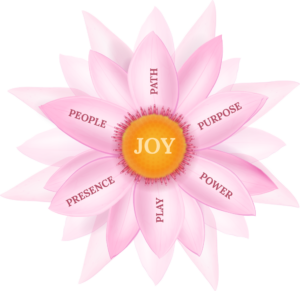
Below are the 6 elements that comprise a joyful life.
Throughout our lives, the elements take on varying significance. At one point in your life, being deeply connected to others and immersed in community may be your gateway to joy, while at other times in your life, discovering your spiritual path through long periods of solitude may be your gateway to joy. All of us define joy in very individual and personal ways that ebb and flow depending on what is happening along the way. There is no right or wrong recipe for joy. Life provides you the beautiful opportunity to define, create, and experience joy in the way that works uniquely for you.
This is simply a framework. My greatest joy is to help you create your most joyful life.
Path
Life Purpose
Internal Power
Presence
Our Chosen People
Intentional Play
Path
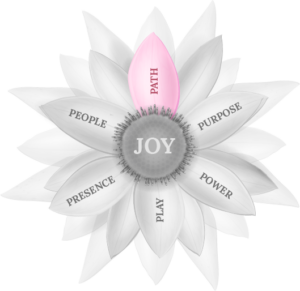
The word “path” has been adopted by people who are on an inner spiritual journey, but it has much wider implications.
Everyone is on a spiritual path, even if they don’t always realize it. And what many people also don’t realize is that “self” and “spirit” are the same. So, the path you are really seeking is the path to know yourself at the deepest level.
As Deepak Chopra teaches, there isn’t a spirit outside of you. You are it. The union of self and spirit is not only possible; it is inevitable. So, the goal of the path is to transform your awareness and move away from the idea of separation of self and spirit to unity of self and spirit. We do not seek spirit outside of ourselves. The purpose of the path is to connect with our spirit that resides within us.
Chopra explains that while inner transformation is taking place along our spiritual journey, every path must have some outer form to sustain it. This form often manifests in prayer or meditation. These are gateways that everyone can use to connect with their own spirit, which is their highest self, unencumbered by the emotional and psychological clutter we accumulate throughout our life.
Being on the spiritual path is such a natural and powerful calling that everyone answers it in their own unique way, regardless of culture or religion. Everybody’s path is uniquely their own. The concept of “trans-spiritual” – the integration of many beliefs, paths, and customs – continues to gain popularity. There are no “right” paths or “wrong” paths.
There has never been a better time to explore or expand your path, due to universal shifts that are occurring. The planet is experiencing a higher level of consciousness and connectedness. Conversations about the unity of self and spirit have migrated from fringe to mainstream, empowering millions to explore what it means to be on “the path.”
Spirituality and science are converging. Awareness of the blend of the physical and metaphysical continues to grow.
Accessibility of resources, education, communities, and guides continues to expand. Never before have people across the globe been so connected and cross-culturized.
The days of following a “guru” are ending; it is time for collaboration and the expansion of the collective consciousness.
The awareness and balancing of feminine and masculine energy continues to grow, paving the way for more connection and understanding among everyone.
Traveling the Path that unifies our self & spirit is one of the 6 foundations for our most joyful life.
Life Purpose
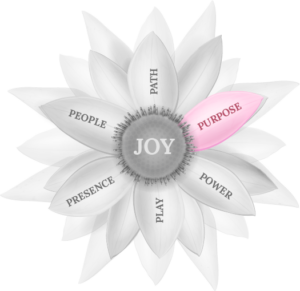
One the most important yet elusive components of our life is Purpose. Purpose creates a connection between oneself and the world in which we exist. Purpose gives us meaning. Discovering our purpose empowers us to claim, “This is why I am here!”
Our lack of clarified purpose consciously or unconsciously compels us to seek meaning in our lives, and often results in unhealthy attachments to people, experiences, places, and habits that temporarily fill a void caused by the emptiness of not knowing our meaning for existence.
Every human being wants to be seen, heard, valued, acknowledged, and validated.
This is the driver behind the search for our Purpose, and why it is so vital to find it.
Internal Power
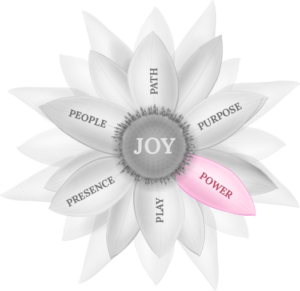
Standing in our Power has nothing to do with dominance over anyone else. Rather, it is a position we assert internally, one in which take full responsibility for the decisions we make, and the seeds we sow.
Do you take full responsibility for where you are in your life, for how you feel, and for the path ahead? Or do you turn over your power to others around you?
When we embrace our Power, we overcome our self-limiting beliefs and create the courage to activate our most joyful life.
Presence
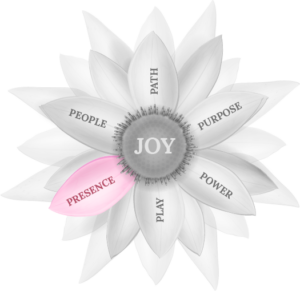 The two greatest thieves of our joy are our memories and our imaginations.
The two greatest thieves of our joy are our memories and our imaginations.
While both can also be wonderful sources of happiness and excitement, too often people are oppressed by these moments in time, instead of liberated from them.
Both exist only in our minds, yet they have so much power over our well-being. The Present moment is the only absolute reality and the true source of Joy.
Our Chosen People
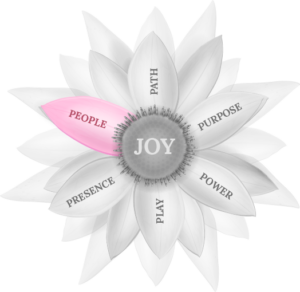 We are all connected. When we become part of the universe, the universe becomes part of us.
We are all connected. When we become part of the universe, the universe becomes part of us.
Forming the right communities and joining the right communities propels personal and organizational growth.
We are not wired to move through the world alone.
Intentional Play
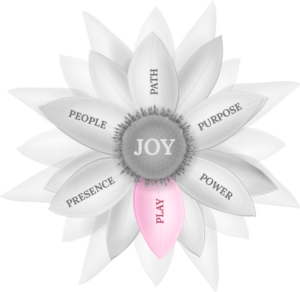 When you close your eyes and think back to your favorite childhood memories, what arises for you?
When you close your eyes and think back to your favorite childhood memories, what arises for you?
For me, it’s running around carefree with dozens of kids in the warm summer months, chasing the ice cream truck with my childhood best friend, swimming in my neighbor’s pool, or playing Chinese jump rope at camp. As an adult, my happiest times are swimming in the ocean, attending a festival, or losing myself in live music at an outdoor concert.
Life is meant to be enjoyed! We are here to laugh, to love, to dream, to live fully.
How do you find laughter in every day? How do you connect with your inner child?
As an adult, it’s essential for our health to stay connected to Play.
Play relieves stress, improves brain function, stimulates creativity, teaches cooperation, heals emotional wounds, builds emotional intimacy and connection, and improves our relationships. Play stimulates laughter which increases oxygen to the heart, lungs and muscles, increases the endorphins that are released by your brain, improves your mood and reduces physical pain. Play connects us to our inner child, and the happiest version of ourselves.
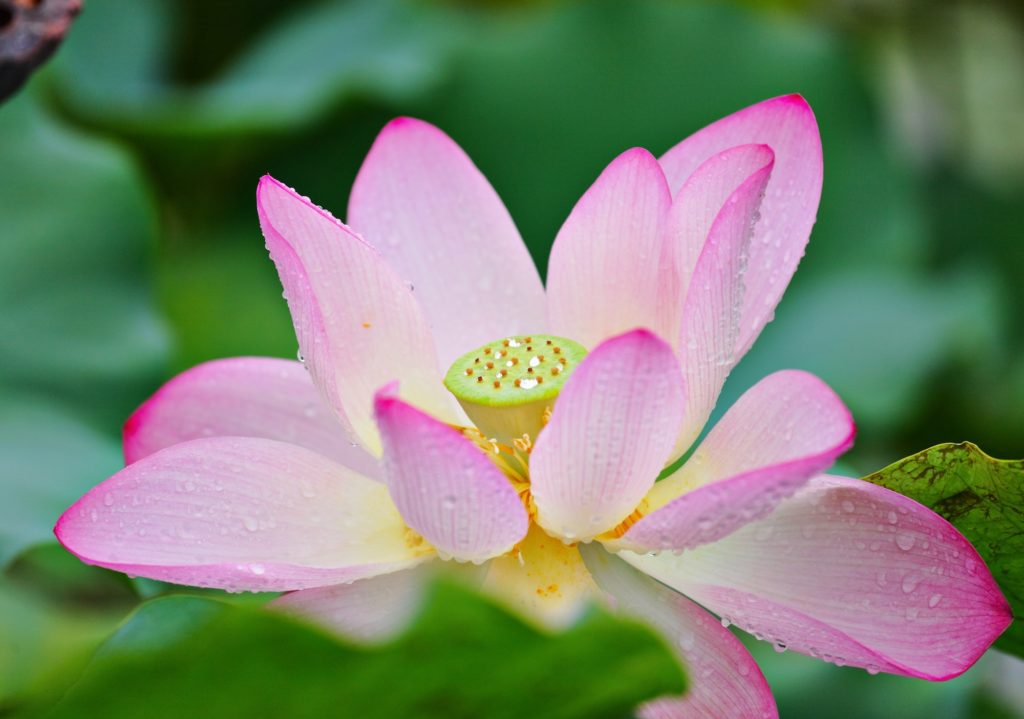
“May we exist in muddy water with purity, like a lotus.”
Why the Lotus?
The path to joy is through transformation, evolution, awakening, and rebirth. Regarded by many cultures as sacred, the lotus is known as the Flower of Life because of their association with the cycle of life, death, and rebirth.
In Buddhism, the fact that lotus flowers emerge from muddy waters symbolizes the act of rising above our challenges and moving towards the light of serenity and wisdom.
In Hinduism, the lotus represents our realization of inner potential through ancient yogic traditions, and is seen as energy moving through the energy centers in our body known as chakras.
In Christianity, the lotus represents purity and transformation. The lotus flower blooms for three days, opening and closing with the sun. Many believe this symbolizes Christ, who took 3 days to resurrect.
Universally, the mud nourishing its roots represents the messiness of our human lives. It is through our human experiences and our suffering that we seek to break free and bloom. But while the flower rises above the mud, the roots and stem remain in the mud, where we live our lives. A Zen verse says, “May we exist in muddy water with purity, like a lotus.“
Unlike other flowers, the lotus has a daily life cycle. It sinks every night into the muddy water and blooms anew in the morning, immaculately clean. This daily resurrection is associated with concepts of spiritual enlightenment and rebirth, thus becoming a symbol of survival.


